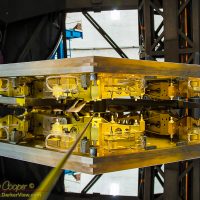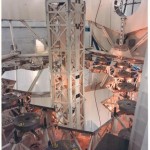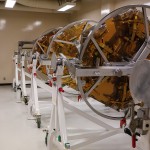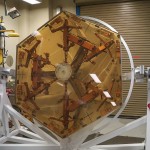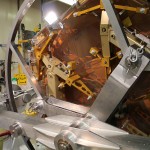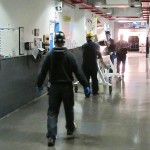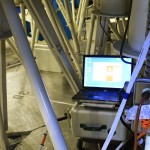
Tag: Keck
Dual Laser Milky Way Photo Op
The island is home to a vibrant community of photographers, a mix of professionals and serious amateurs. There is one set of photos everyone, and I do mean everyone wants… Dual lasers on the Milky Way.

Opportunities to see and photograph this are few, and occur strictly during the summer months of June to August, when the Milky Way is high overhead. furthermore, these opportunities occur only when Andre Ghez and her UCLA Galactic Center Group have both telescopes scheduled.
July 25th was such a night, a good opportunity to get both lasers. Andrea’s group has the first half of the night, turning over the ‘scopes to other astronomers just after midnight. Actually there were a few nights this particular week, we just chose the 25th. After this galactic center season is over, at least until next year.
Dark Night Laser
Service Call
It does not happen very often, but it does happen. Driving up to the summit in the night to fix the telescope. As an operations engineer it is part of the job, but I can think of only a handful of times in my decade on the summit I have actually done it.

This particular problem was discovered first thing upon opening. Well? Lack of opening for the night. The top shutter on Keck 2 would not move, fault lights all over the place. Hard to look at the sky with the top shutter closed. I worked the issue over the phone for a while with Nick as far as we could.
The conclusion? I would have to work the problem in person to fix it, I have to go up.
Can I fix this? Probably. I found myself leaving the house before 9pm for a run to the summit.
IRTF, CFHT, and Gemini
Unexpected Classification of Exoplanets Discovered
W. M. Keck Observatory press release…
Since the mid-1990s, when the first planet around another sun-like star was discovered, astronomers have amassed an ever-expanding collection of nearly 3,500 confirmed exoplanets.
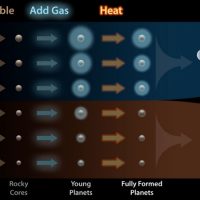
“This is a major new division in the family tree of planets, analogous to discovering that mammals and lizards are distinct branches on the tree of life,” says Andrew Howard, professor of astronomy at Caltech and a principal investigator of the new research.
The lead author of the new study, to be published in The Astronomical Journal, is Benjamin J. (B. J.) Fulton, a graduate student in Howard’s group.
In essence, their research shows that our galaxy has a strong preference for either rocky planets up to 1.75 times the size of Earth or gas-enshrouded mini-Neptune worlds, which are from 2 to 3.5 times the size of Earth (or somewhat smaller than Neptune). Our galaxy rarely makes planets with sizes in between these two groups.
“Astronomers like to put things in buckets,” says Fulton. “In this case, we have found two very distinct buckets for the majority of the Kepler planets.”
Continue reading “Unexpected Classification of Exoplanets Discovered”
Astronomers Prove What Separates True Stars from Wannabes
W. M. Keck Observatory press release…
Astronomers have shown what separates real stars from the wannabes. Not in Hollywood, but out in the universe.
“When we look up and see the stars shining at night, we are seeing only part of the story,” said Trent Dupuy of the University of Texas at Austin and a graduate of the Institute for Astronomy at the University of Hawaii at Manoa. “Not everything that could be a star ‘makes it,’ and figuring out why this process sometimes fails is just as important as understanding when it succeeds.”
Dupuy is the lead author of the study and is presenting his research today in a news conference at the semi-annual meeting of the American Astronomical Society in Austin.
He and co-author Michael Liu of the University of Hawaii have found that an object must weigh at least 70 times the mass of Jupiter in order to start hydrogen fusion and achieve star-status. If it weighs less, the star does not ignite and becomes a brown dwarf instead.
How did they reach that conclusion? The two studied 31 faint brown dwarf binaries (pairs of these objects that orbit each other) using W. M. Keck Observatory’s laser guide star adaptive optics system (LGS AO) to collect ultra-sharp images of them, and track their orbital motions using high-precision observations.
“We have been working on this since Keck Observatory’s LGS AO first revolutionized ground-based astronomy a decade ago,” said Dupuy. “Keck is the only observatory that has been doing this consistently for over 10 years. That long-running, high-quality data from the laser system is at the core of this project.”
Continue reading “Astronomers Prove What Separates True Stars from Wannabes”
Segments!!
On the Dome
Fun at AstroDay
In the ten years I have lived on island I have never missed an AstroDay. This year was no change to that streak, I volunteered to do the last shift on the Keck Observatory table, 2-4pm. Show up at lunchtime, enjoy the activities myself for a while, say hi to everyone I know there, then do my shift on the table… Good plan.

I was pleasantly surprised with this little thermal camera, it does a nice job costing only a few hundred dollars. Using the iPad linked to a large display using AirPlay the setup worked quite well in practice. I could handle the camera with no wires to tether me to one place.



